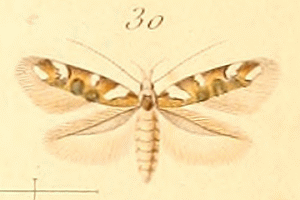Isidiella divitella
| Isidiella divitella | ||||||||||||
|---|---|---|---|---|---|---|---|---|---|---|---|---|

Isidiella divitella |
||||||||||||
| Systematics | ||||||||||||
|
||||||||||||
| Scientific name | ||||||||||||
| Isidiella divitella | ||||||||||||
| ( Constant , 1885) |
Isidiella divitella is a butterfly ( moth ) from the family of cosmopterigidae (Cosmopterigidae).
features
The moths reach a wingspan of 8.5 to 12.5 millimeters. The head shines white. The antennae have a brown sheen and are indistinctly ringed in white in the second half. The thorax shines white and on the sides golden. The tegulae have a golden sheen and are lined with white at the back. The front wings shine golden and are golden brown on the Costa loader. An indistinct golden-brown basal line runs between the anal fold and the inner edge of the wing. The rest of the wing markings are largely identical to Isidiella nickerlii , but the costal lines are more prominent and the raised, pale golden spots are smaller. The apical spot is white.
The genital armature of the males is similar to that of Isidiella nickerli , but the Valven are slimmer, the right Valvella is shorter and wider. The diameter of the ductus ejaculatoris at the confluence with the aedeagus is half as large as the largest diameter of the bulbous part of the aedeagus.
The genital armature of the females is similar to that of Isidiella nickerli , but differs in the only thinly sclerotized posterior end of the ostium and the indistinct posterior sclerotization of the 7th sternite . The ductus bursae is shorter than the corpus bursae .
Similar species
The two most obvious differences between Isidiella divitella and Isidiella nickerlii are the white head and the broad white dorsal line on the thorax.
distribution
Isidiella divitella is native to the western Mediterranean region (southern France , Corsica , Sardinia , Spain , Portugal ).
biology
The caterpillars develop on the Italian straw flower ( Helichrysum italicum ), Mediterranean straw flower ( Helichrysum stoechas ) and Holy herb ( Santolina ). They attach a spherical cocoon to a stem , from which twisted tubes extend to neighboring leaves, in which the caterpillars mine. The cocoon has the appearance of a plant bile and is covered with plant hair on the outside. It serves as a hiding place during the feeding breaks and the adult caterpillars pupate in it. The moths fly from June to August.
Systematics
The following synonyms are known:
- Stagmatophora divitella Constant , 1885
- Stagmatophora nickerli tyrrhenica Hartig & Amsel , 1939
supporting documents
- ↑ a b c d e f g J. C. Koster, S. Yu. Sinev: Momphidae, Batrachedridae, Stathmopodidae, Agonoxenidae, Cosmopterigidae, Chrysopeleiidae . In: P. Huemer, O. Karsholt, L. Lyneborg (eds.): Microlepidoptera of Europe . 1st edition. tape 5 . Apollo Books, Stenstrup 2003, ISBN 87-88757-66-8 , pp. 150 (English).
- ↑ leafminers of Europe. Isidiella divitella (Constant, 1885). (No longer available online.) Willem N. Ellis, archived from the original on September 26, 2012 ; Retrieved February 27, 2012 . Info: The archive link was inserted automatically and has not yet been checked. Please check the original and archive link according to the instructions and then remove this notice.
- ^ Isidiella divitella in Fauna Europaea. Retrieved February 27, 2012
Web links
- Determination aid of the Lepiforum for the butterfly species found in Germany, Austria and Switzerland. Isidiella divitella (CONSTANT, 1885). Lepiforum e. V., accessed February 27, 2012 . Initial description